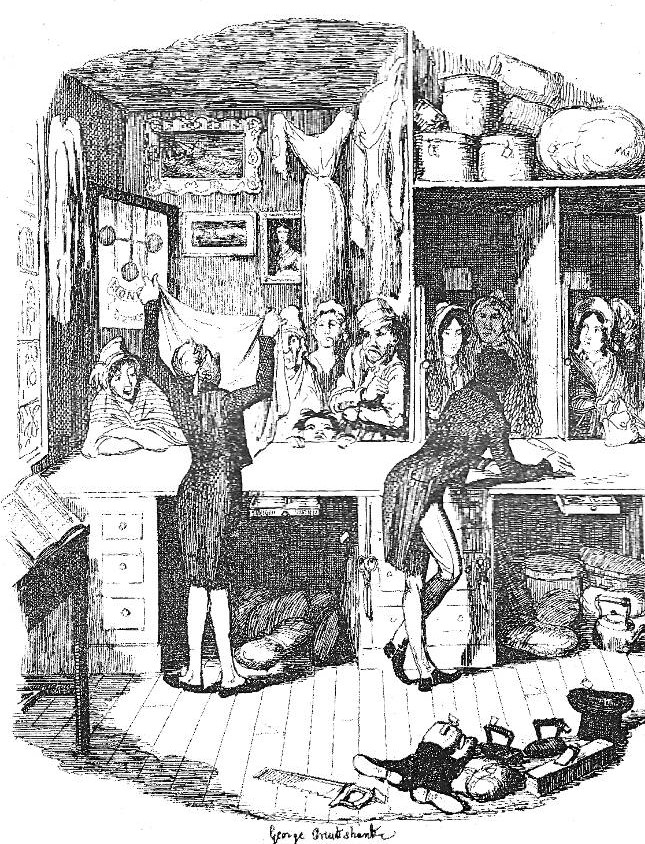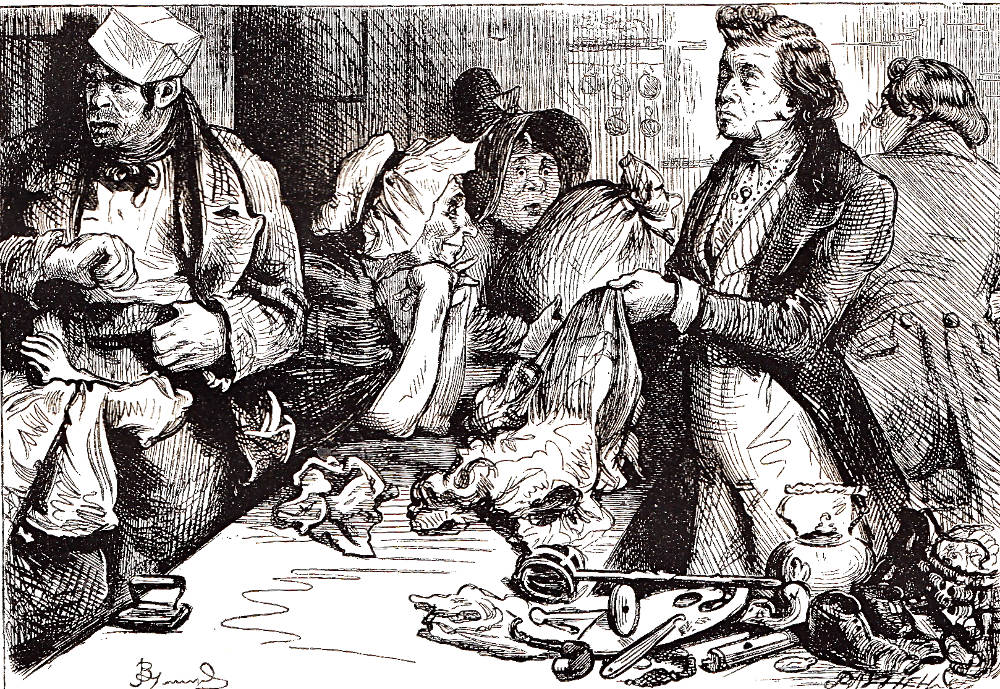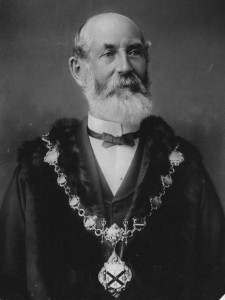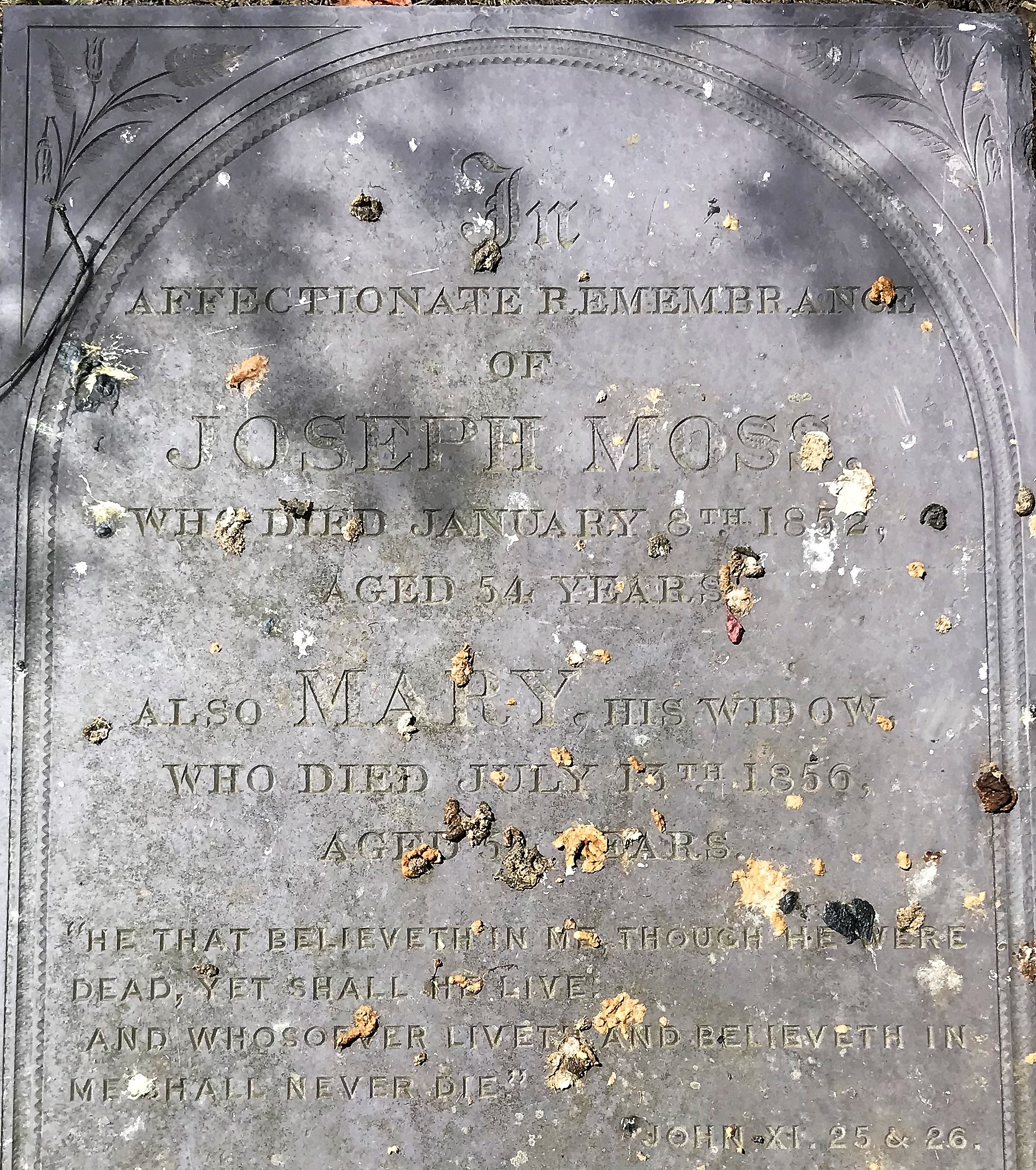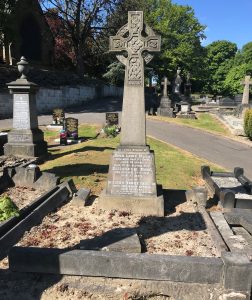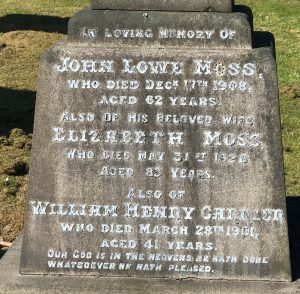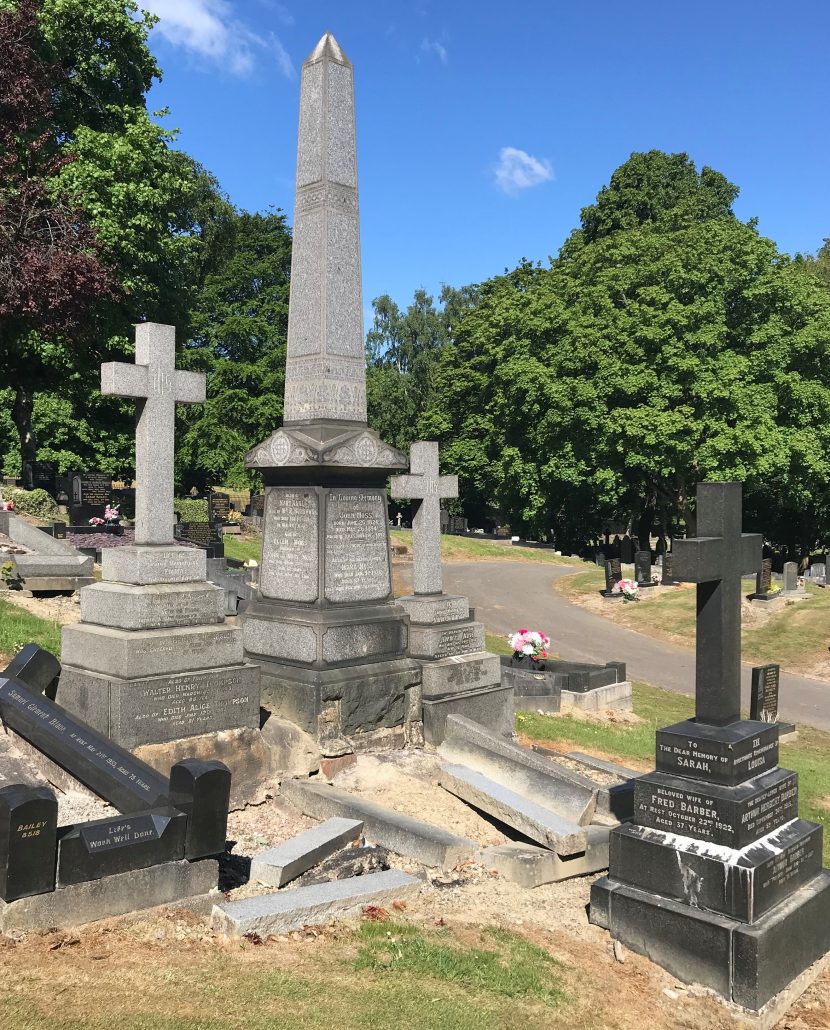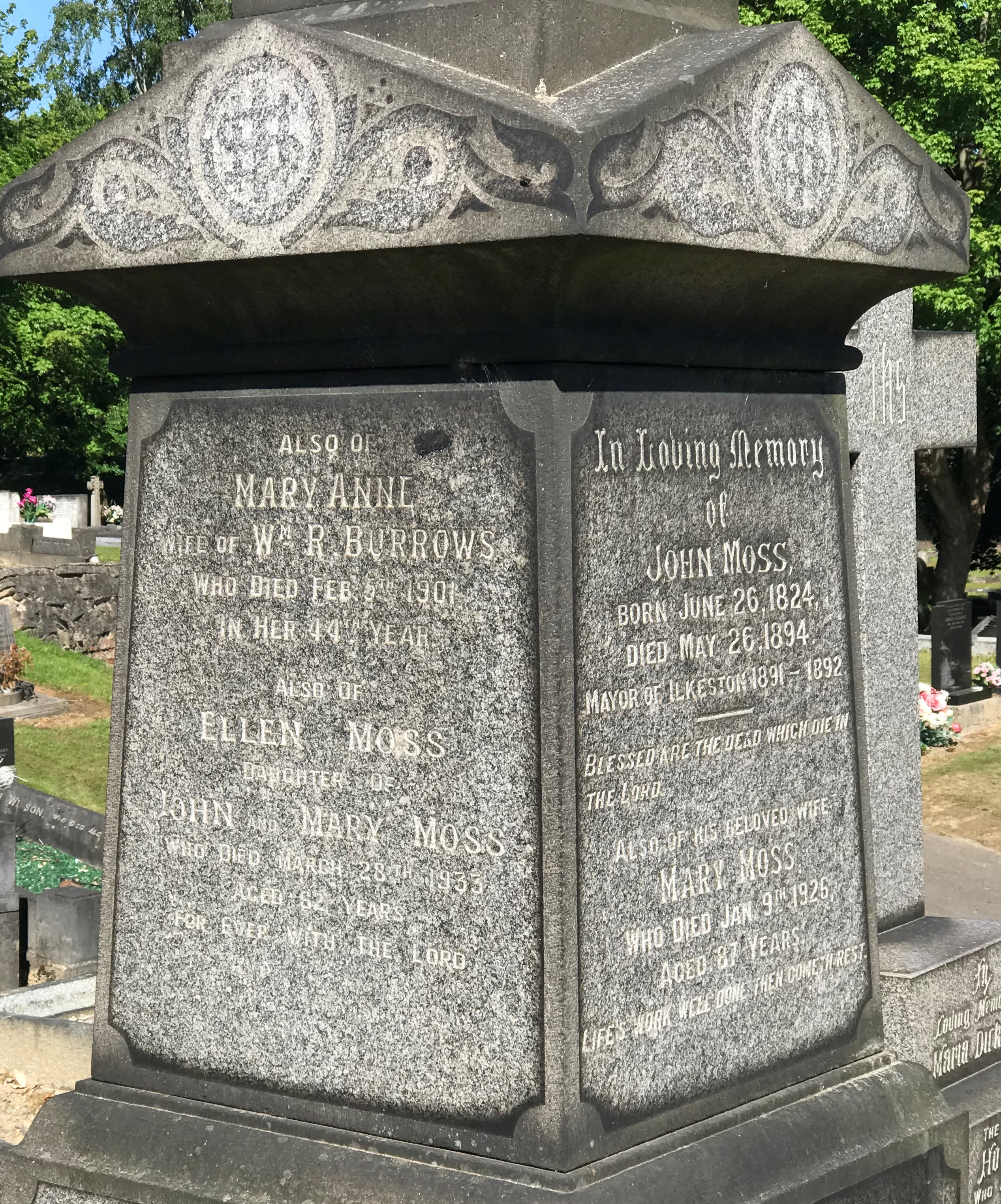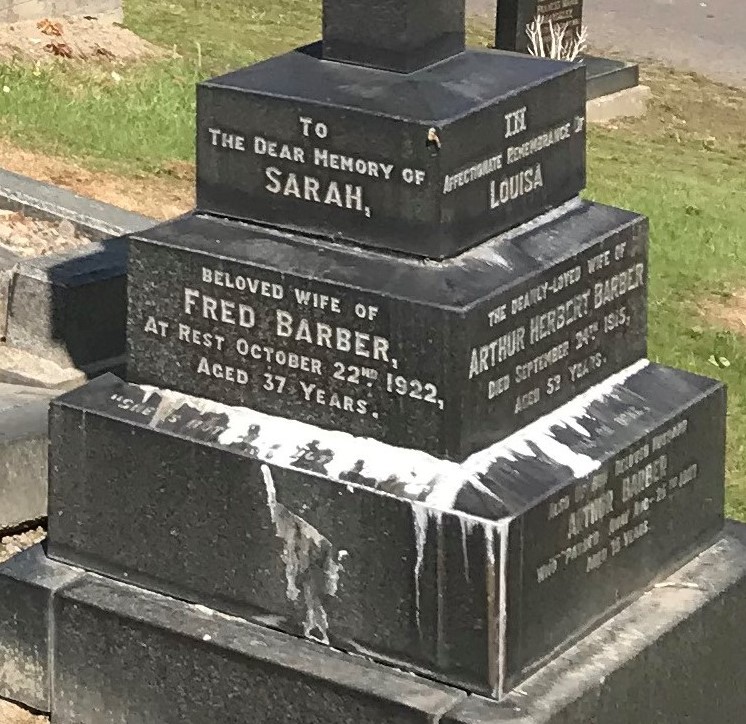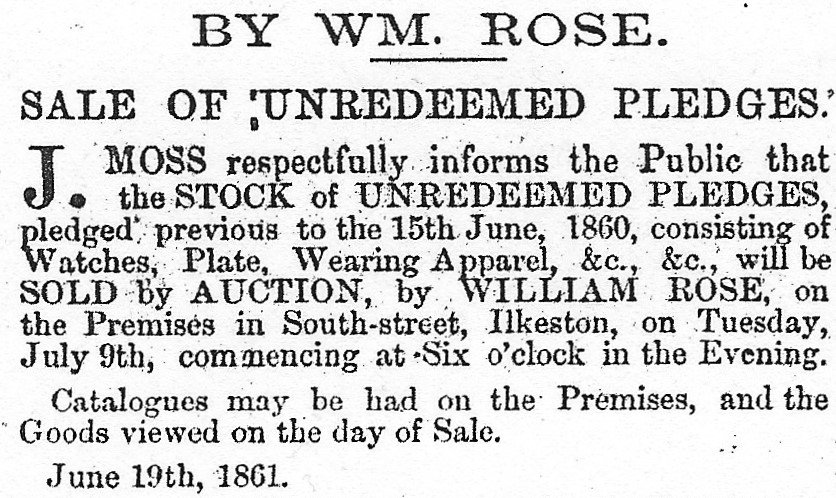We have just walked past The Prince of Wales, and Adeline remembers that “Mr. John Moss had two shops, for his pawnbroking and tailoring business, started in the late fifties.”
The Pawnboker’s shop (inspired by Charles Dickens’ “Scenes” and “Sketches” by Boz)
This was 52 South Street (East Side) in 1871. However, with renumbering of the street, a few years later, and it was 16 & 17 South Street. Further renumbering about 1888 and it was then 65 South Street, and remained so until the end of the century.
—————————————————————————————————————————————————
John Moss in Court
In March 1863 two men entered John’s shop and attempted to pawn a silver cream-mug and a silver-plated mustard-pot.
The broker was suspicious. He placed the articles in his desk and was about to detain the visitors when they scarpered, nicking a cloth cape and a coat as they left.
Persistent John cried ‘stop thief!’ and then endeavoured to follow his own instructions. He chased the pair unsuccessfully for three miles and as a consequence suffered severely for the following three weeks.
Later the silver items were handed over to the police together with a description of the two men and further information which soon led to the arrest and conviction of a brace of Belper brigands.
The stolen property belonged to Joseph Palmer, currier of Bridge Street in Belper, who had offered a £5 reward for information leading to the conviction of the thieves and who now promised that sum to John. The Belper New Association for the Prosecution of Felons offered an additional reward of £10 as part of its policy to pursue villains. The situation however was complicated by the fact that several other witnesses had given information to the police and it had to be decided who was entitled to how much of the rewards.
Thus John waited for his share …and waited…and waited….
…and waited.
Two years elapsed and the pawnbroker’s patience was exhausted such that he sued Joseph Palmer through Belper County Court for ‘the recovery of the reward’.
The judge pondered long and hard on the case and his deferred decision was that, because of the significance of John’s evidence, especially in apprehending and convicting one of the thieves, he was entitled to the whole reward.
A month later and John was back at the same court, now suing for the recovery of the reward offered by the Belper New Association.
The same arguments were heard and the same judge gave the same verdict. He was surprised that the Association had even brought the matter to court and had not yet paid out the reward. It would have been more to its credit had its members had said to John ‘You have given the information and we are very willing to pay you the reward’.
John left the court £10 richer.
Coincidentally at the first Belper hearing — when John was the plaintiff — his son John Lowe Moss appeared as a defendant in a separate case when he and printer William Brentnall Wheatley were charged by Bath Street tallow chandler Moses Mason with causing damage to a trap owned by the latter.
Moses had a licence to let out horses and traps and in October 1864 had hired out both to John and William. When they returned the trap, the shaft and splashboard were broken and wheelwright Joseph Scattergood had to be hired to effect the repairs. Moses was now claiming for the damages.
There was a defence however.
The hiring was illegal as it had taken place on Sunday and John was not yet 21 – he was 18 — under age to hire the vehicle. He thus made a plea of infancy but the judge was having none of this. There was joint possession of the trap, both John and William were under an obligation to return it as they got it and so both were responsible for the damage.
“A plea of infancy to break a trap to pieces, or a man’s head, or anything of that sort, was no defence”.
Both defendants were ordered to pay.
John’s persistence was also demonstrated in 1877 when again he was ‘galloping’ down South Street towards the old toll-bar, again crying “stop thief!” in pursuit of a skirt, attached to which was Myra Copen, but which minutes earlier had been hanging on a rail inside his shop.
He apprehended Myra and handed her over to the police despite her pleading for forgiveness and to be allowed to pay for the skirt.
Sentenced to the House of Correction for a month.
——————————————————————————————————————————-
John Moss in Office
During his life John senior was a member of the Local Board, the School Board (being elected onto the first one in 1878), a National School manager, Overseer of the Poor, an Oddfellow (Rutland and Earl Grey Lodges) and Freemason (Rutland Lodge), a Churchwarden, member of the Town Council, then Alderman, and in 1891 he was chosen as the fourth Mayor of the Borough.
John Moss, Mayor of Ilkeston 1891-1892. (Ilkeston Reference Library)
John’s position as Mayor of Ilkeston allowed him to sit in judgement on the bench of the Petty Sessions, and it was there, in May 1892, that he found himself in a rather ‘uncomfortable’ position. Sitting with co-judges Francis Sudbury and John Ball, he saw before him James Shaw, accused of stealing a pair of boots and a vest from Messrs Weatherhogg and Son, pawnbrokers of Granby Street — and a topcoat from John’s own shop in South Street. Of course John did the right thing and recused himself at that point, while incontrovertible evidence was amassed against James. Numerous witnesses testified that he had stolen all the items and and ‘legged it’, eventually down Derby Road where he was taken into custody by P.C. Else. James pleaded guilty but with extenuating circumstances — he was totally drunk at the time !! This defence didn’t prevent him from serving the next two months in prison.
P.S. The choice of one of James’s stolen items was obvious when he stood, bare-footed, in the dock.
—————————————————————————————————————————————————-
John Moss and Emma, his first wife.
Born on June 26th, 1824 John Moss was the oldest son of labourer Joseph and Mary (nee Lowe).
His father was born at Cheadle in Staffordshire, the son of farmer Joseph senior and Margaret (nee Whiston).
Born in Heanor, Derbyshire, his mother was the eldest daughter of joiner Christopher and Mary (nee Allen).
His parents are buried together in St. Mary’s graveyard.
Their stone (right) can be found at the south side of the church.
The 1841 census records John Moss working in Nottingham Road for his maternal grandfather Christopher Lowe, maltster, while in Bagshaw’s Directory of 1846 John himself is a maltster of Nottingham Road, Christopher having died the year before. About that time (1845) John commenced as a linen and woollen draper of South Street and ‘took out a licence as a pawnbroker in 1854’. (Trueman and Marston)
Adeline also recalls that “he had one son and two daughters by his first wife”. (not quite accurate, Adeline )
John had married Emma Noon, daughter of Samuel and Mary (nee Hardy) on September 15th, 1845.
They had at least six children together before Emma died aged 36, on February 9th 1859, from chronic bronchitis, a few days after the premature birth of son Edwin Noon Moss (February 4th).
——————————————————————————————————————————————
Their children…..
Adeline recalls that their first child “John married Miss Lizzie Barker of Burr Lane. He had a tailor and outfitting business in Bath Street.”
On March 4th, 1868 their oldest son, John Lowe Moss (July 8th, 1846 – December 17th, 1908), married Elizabeth, daughter of James Alexander Barker, butcher of North Street, and Matilda (nee Ball), and for a time John assisted in his father’s business.
Then, for a few years from the early 1870’s, he traded as a clothier in Market Street, Eastwood, before returning to his Bath Street branch in 1881.
“From May 1885 John Lowe Moss of Bath Street, Ilkeston, and Market Street, Eastwood, will close Thursday half-day to allow his assistants to have their half-day holiday”. (IA 1885)
And it was a couple of months after this that John Lowe was out fishing in Trent Lake with a friend from Nottingham. They were taken out on the lake by 30-year-old John Henry Widdowson, boat builder and proprietor of the lake. It was quite a rough afternoon and John Henry was tying up the boat to another stake boat when, pulling on the anchor, he seemed to fall and disappear under the water. Despite frantic efforts to reach and save him, John Henry perished and his body was recovered about 12 yards from the staked boat.
John Lowe Moss continued trading as a clothier and outfitter at 44 Bath Street. This shop was the northern neighbour of Smith & Co’s Bank, standing approximately where Bostock’s Row used to be before it was demolished. And like his father, John Lowe was no stranger to the local courts.
On Thursday night, April 28th 1898 and close to midnight, John was walking down Bath Street, returning to his home in the company of his friend Councillor Frederick Chambers. They stopped to finish a brief conversation when John saw a man hurriedly approaching them. When he looked again the man had mysteriously disappeared. However as he arrived at his home John discovered the man –whom he recognised as William Holmes, landlord of the Sir John Warren — urinating in the passage next to his house. He called to William to come out, took him by the collar and dragged him into the street. The landlord was quite drunk and swore at John, lashed out at him and threatened further violence, though the clothier refused to take advantage of his drunken state which just about rendered him defenceless. This was John’s version of the argument and he was sticking to it !! — though of course William told a slightly different account of how a ‘forceput’ had caused him to go into the entry, of how John had collared him and thrown him into the gutter,. and had taken a swipe at him whilest promising to knock his teeth down his throat.
The dispute came to the Petty Sessions after a desperate attempt to settle the matter without the court proved fruitless — as it so often did in Ilkeston !!. John wanted a public apology plus a donation of two guineas to the hospital fund, and when this was refused the case went before the magistrates. As well as the two warring parties, several witnesses spoke in court. Under sub-pœna Councillor Chambers seemed reluctant to fire both barrels at the landlord of the Sir John Warren, hadn’t seen any blows struck and had difficulty in recognising what drunkenness looked like. John’s wife Elizabeth had seen only the tail-end of the altercation, but sufficient to put the blame squarely on William’s shoulders !! On the evening of the dispute the latter had just visited Joe Richards, landlord of the Queen’s Head at number 48. Joe testified that he had tried to intervene, William wasn’t drunk but had had only a couple of whiskies and a cigar, and was merely tried to defend himself, although he had to be ‘escorted home’ by the pianist of the Queen’s Head. However the court adjudged that he was the one to blame for the ruckus and was fined 5s with costs.
John Lowe died at his Bath Street home in December 1908, aged 62.
John Lowe Moss was buried in a family grave in Park Cemetery, with his wife Elizabeth. Also with them is William Henry Carrier, son of Bath Street draper Joseph and Jane (nee Attenborough); he married Matilda Moss (1869-1951), the eldest child of Joseph Lowe and Elizabeth. At the time of their marriage, William Henry was the principal representative of the firm of Henry Carrier & Sons and had been so for ten years, since the death of his father Joseph. He was living at Uplands in Burr Lane and his firm was described as the oldest manufacturing firm in Ilkeston, “having been established over 100 years ago”. Matilda was a gifted vocalist and musician, a member of the Ilkeston Harmonic Society and a principal singer in the choir of the Independent Chapel. At the ceremony a long roll of carpet stretched from the Pimlico chapel to the Market Place to protect the train of the bride’s wedding dress. The honeymoon was spent in London and Paris — and thence back to ‘Uplands’.
Having returned from their honeymoon, the couple entertained over 200 workers of H. Carrier & Sonsto tea at the Town Hall, provided by Charles Hiram Gregory of the Old Wine Vaults. This was followed by a dance.
Albert (December 1st, 1851-?) left the area as a young man, married in London in 1876 and then went north to the Birmingham and Dewsbury areas (and Lancashire) working as a pharmaceutical chemist.
“Emma, eldest daughter married Mr. Henry Thompson, draper, Bath St., now H. Carrier & Sons’ offices.”
Emma (March 13th, 1854- June 20th, 1923) married Henry Thompson, draper and hosier of Bath Street on December 24th 1878.
Henry was born in Radford, Nottingham in 1850, the son of miller Thomas and Patience (nee Bates).
By 1878 he had worked as an assistant at the Bath Street shop of draper Joseph Carrier for 14 years, and in the month before his marriage had branched out on his own. He opened his draper’s shop at 108 Bath Street, next door to Richard Riley, at premises recently occupied by watchmaker Henry Hoggarth Beaumont.
(Henry Hoggarth had established himself in Ilkeston in 1867 as a jeweller and dealer in musical instruments and in 1878 moved into the premises previously occupied by clothier John Stinson – at 95 Bath Street, opposite the Primitive Methodist Chapel).
About 1884, Henry Thompson moved out of this shop, at number 108, and up Bath Street, into part of the premises owned by the Carrier family (as Adeline mentions above), just below the Borough Arms … this was 113 Bath Street but a few years later was renumbered as 12 Bath Street. (And as Henry moved out of number 108 into it came ironmonger George Andrew.)
On Saturday afternoon, November 30th 1889 — it was about 5 o’clock so it was getting pretty dark, and the gas jets in the shop window had been lit for a short time — a fire broke out at the premises. It was later thought that as it grew darker and the lamps were turned up, the increased heat broke a globe protecting the contents of the window from the gas; this may have caused the accident, though no-one was ever sure. There were three shop windows in Henry’s premises, the fire occurring in the ‘Manchester window’, where rolls of cotton and linen goods were displayed. Almost immediately a crowd assembled and began to drag burning drapery goods into the street, extinguishing the flames however they could. Other helpers brought buckets of water and poured it onto burning material in the window. The fire was brought under control although Henry had severely burned his hands in his attempts to cope wth the flames. Fortunately the prudent draper had secured ‘contents insurance’ !!
“Pollie married Mr. Burrows, a schoolmaster”.
In May 1879 daughter Mary Anne alias Pollie (January 20th, 1856- February 5th, 1901) married Beeston-born National School master William Ralph Burrows and moved to Monmouthshire.
Son Edwin Noon died aged three weeks (February 4th-28th, 1859) and an unnamed daughter (October 21st, 1849) died after one hour.
—————————————————————————————————————————————-
John Moss and Mary, his second wife
Three months after his wife Emma’s death John Moss married his second wife and Emma’s half-sister, Mary Scattergood, daughter of John, boot and shoemaker of South Street, and Mary (nee Hardy, formerly Noon).
This union resulted in nine more children for John Moss although not all of them survived infancy.
In the summer of 1890 the Moss family received a visit from Mary Moss’s sister Sarah (nee Scattergood) – John’s sister-in-law.
The latter had married Nottingham baker and confectioner William Gadsby on New Year’s Day in 1868 after which and for a short time they had gone to live in Nottingham.
In the early 1870’s the family left to live at Fall River, Massachusetts and it was from there that Sarah was making her visit.
Sadly during her visit she died at the Moss family home in South Street and is buried in St. Mary’s Churchyard with John’s first wife Emma and his sister Hannah.
Of the children of John and Mary….
Louisa (March 7th, 1863-September 24th, 1915) married commercial clerk Arthur Herbert Barber on November 12th, 1884. He was the elder son of Stanton by Dale lacemaker David and Mary (nee Plumb) and was employed as a clerk at Stanton Iron works.
The couple then lived at Lillock Road in Stanton by Dale.
Suffering from extreme nervous depression in 1915, Louisa’s body was recovered from the Erewash Canal, the assumption being that she had committed suicide. Her family home was then at ‘Braeside’ on Longfield Lane.
In February 21st, 1882 Lucy (December 6th, 1864- July 25th, 1940) married tailor, clothier and outfitter Josiah Sutton, born in Leicester, the son of timber merchant Robert and Catherine (nee Haddon). They lived for a few years at Clay Cross where Josiah had a shop before returning to Bath Street about 1887.
He traded at 59 Bath Street and that is where he died in February 1917, aged 60. Lucy died at 10 Grenville Drive, Stapleford.
Money lender Horace (August22nd, 1868- January 23rd, 1945) was educated at St. Mary’s School, Ilkeston, under headmaster William Frost, and then at the Collegiate School, Morley.
On September 2nd, 1890 he married Maria Dickenson Wood, daughter of North Street baker Samuel and Susannah (nee Straw).
For several years their family home was at Cotswold House in Lord Haddon Road.
Ellen the second (June 14th, 1870- March 28th, 1933) lived, unmarried, with her parents.
For her first husband Elizabeth (May 17th, 1872- 1954?) married grocer’s assistant John William Winrow on December 6th, 1898.
Born in Dale Abbey he was the son of grocer Stephen, who traded in Town Street, Sandiacre before his death in 1886, and Hannah Mary (nee Salt).
John William also died in Town Street in May 1911 and eight months later, on January 13th, 1912, his widow Elizabeth married auctioneer and widower William Briggs junior, son of Ilkeston watchmaker and jeweller William senior and Mary (nee Barlow).
And after William junior died in 1931, Elizabeth married again, on November 21st, 1946, to Edwin Moore
I believe she died in Ilkeston in 1954, aged 81.
Accident Alert !! September 23rd 1891. Son Frederick Moss (July 3rd, 1874-?) was riding his bike along Cotmanhay Road when he collided with a horse and cart, belonging to farmer Phillip Walker of Shipley. He was thrown into the road and hit his head with such force that he remained unconscious for some time. Fred had to be carried to the home of Dr. Robert Wilkinson, next to the Jolly Colliers Inn, to be treated, before recovering his senses, and returning home.
On August 9th, 1913, now an accountant and money lender, Fred married Hilda Maud Humphrys, daughter of Ilkeston Gas Works manager Frederick Chilton and Rebecca Florence (nee Porter) of Charnwood House in St. Mary Street.
An unnamed daughter died at birth (March 7th, 1860); son Joseph (April 28th, 1861- November 11th, 1863) and daughter Ellen the first (from measles and pneumonia, November 23rd, 1866 – November 27th, 1867) both died in infancy
—————————————————————————————————————————————————-
The Moss family at rest
On December 22nd, 1893, the Pioneer reported that John Moss “lies seriously ill at his residence in Ilkeston, having been seized .. with a paralytic stroke”. At the same time, his wife Mary was “dangerously ill from pneumonia supervening upon an attack of influenza”.
And after an illness of four or five months’ duration John died at his South Street home on Saturday, May 26th 1894.
He was buried at Park Cemetery on the following Wednesday after a service at the Parish Church which was accompanied by vivid lightning and reverberating thunder. At the service the mourners had to wait for an hour inside the church until the storm subsided. Edward Chadfield, the church organist, was up to the challenge however and had plenty of appropriate music to relieve the monotony of his ‘captive audience’.
The Advertiser noted that “a force of constabulary, under Inspector Savoury, preserved order at the church gates, and elsewhere where the crowding may have caused inconvenience”.
John’s second wife Mary recovered from her pneumonia of 1893 and died at 29 Gregory Street on January 9th, 1926.
The photo above shows the Moss family graves. The monument, centre, is the stone of John Moss (1824-1894), his second wife Mary (1838-1926), and his daughters Mary Ann (1856-1901) and Ellen (1870-1933)
The larger cross to the left is above the grave of daughter Emma (1854-1923), her husband Henry Thompson (1850-1937), their son Walter Henry (1879 -1948), and his wife Edith Alice (nee Gibson) (1882-1963).
The smaller cross is the grave of son Horace (1868-1945) and his wife Maria Dickinson (1871-1928)
The black cross on the right marks the grave of daughter Louisa (1863-1915), married to Arthur Herbert Barber.
Below are photo details from the monuments
———————————————————————————————————————————–
Before we cross Gladstone Street we note that on the Local Board Map of 1866 that street was named as Pledge Street, perhaps a reference to the trade of John Moss ? …

